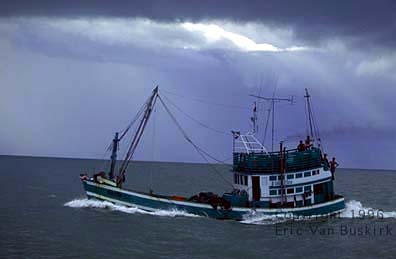
These wayward fishermen keep a keen eye on a ferry full of, mostly, Western back-packers en route to the mainland from Koh Samui island.
The Gulf of Thailand is a gulf located in the South China Sea (Pacific Ocean), surrounded by the countries Malaysia, Thailand, Cambodia and Vietnam. The north tip of the Gulf is the Bight of Bangkok at the mouth of the Chao Phraya River, near Bangkok. The gulf covers roughly 320,000 km². The boundary of the gulf is defined by the line from Cape Bai Bung in southern Vietnam (just south of the mouth of the Mekong river) to the city Kota Baru on the Malayian coast.
The Gulf of Thailand is relatively shallow, the mean depth is 45 m, and the maximum depth only 80 m. This makes water exchange slow, and the strong water inflow from the rivers make the Gulf lower in salinity (3.05-3.25%) and also rich in sediments. Only at the higher depths water with a higher salinity (3.4%) flows into the gulf from the South China Sea and fills the central depression below a depth of 50m. The main rivers which empty into the gulf are the Chao Phraya (including its distributary Ta Chin) and the Maeklong at the Bight of Bangkok, and to a lesser degree the Tapi River into the Bandon Bay in the southwest of the gulf.
At the height of the last ice age the Gulf of Thailand did not exist at all due to the lower sea level, but did instead continue the Chao Phraya river valley.
Due to the tropical warmth of the water the Gulf of Thailand harbours many coral reefs, and thus several diving resorts. Most popular for tourism is the island Ko Samui in the Surat Thani province, while Ko Tao is the center of the diving tourism.
The gulf also contains some oil and to a larger degree natural gas resources.